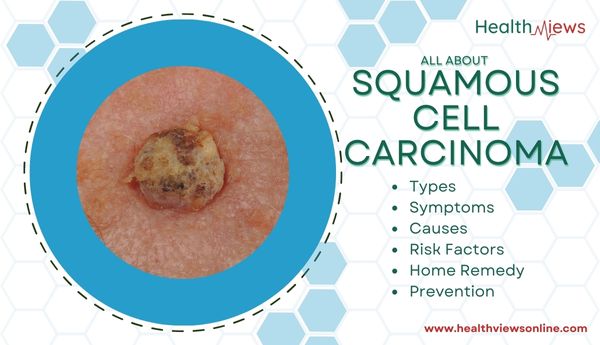What is Squamous cell carcinoma?
Squamous cell carcinoma of the skin is a type of skin cancer that develops in the squamous cells that make up the middle and outer layers of the skin.
This malignancy of the skin typically poses little threat to life. It can grow deeply, although it usually grows slowly. Untreated skin squamous cell carcinoma can grow large and spread to other parts of your body, posing a serious threat to your life. Deep cancers have the potential to harm blood arteries, nerves, and other structures in their path.
It is a kind of cancer that can appear everywhere there are squamous cells (SCC).
Types
Squamous cell carcinoma mainly comes in the following forms:
- Squamous cell carcinoma of the skin: Squamous cell carcinoma of the skin develops on the skin’s surface, in the epidermis. These cells appear flat under a microscope. Squamous cell carcinoma, like basal cell carcinoma, develops on sun-exposed skin, such as the skin on the head, neck, and face. Source
- Squamous cell carcinoma of head and neck: Squamous cell carcinoma of the head and neck develops on the skin’s outermost surface or in specific tissues within the head and neck region, such as the sinuses, nose, mouth, and throat. Squamous cell carcinoma accounts for roughly 90% of all head and neck cancers. Source
- Squamous cell carcinoma of the genitals – Squamous cell carcinoma is a type of cancer that appears in the epithelial lining of the penis, cervix, vulva, and vagina. Human papillomavirus (HPV) infection is frequently linked to genital squamous cell cancer. Squamous cell carcinoma predominates in cases of vaginal, vulvar, cervical, and penile cancer. Source
Causes
Squamous cell carcinoma of the skin develops when the DNA of the flat, thin squamous cells in the middle and outer layers of your skin changes (mutates). The DNA of a cell contains the instructions that tell the cell what to do. The mutations instruct the squamous cells to proliferate uncontrollably and to live when normal cells would die.
UV rays, such as those emitted by the sun or a tanning bed, affect the cells in the middle and outer layers of your skin, causing them to proliferate and fail to die off as they should. This can result in out-of-control cell growth, which can lead to squamous cell carcinoma.
Also Read: Actinic Keratosis: Types, Causes, Risk Factors, Prevention, Home Remedy, Facts
Risk factors
Certain factors increase your chances of developing SCC:
- Progressive age
- Male
- Fair-skinned
- Eyes that are blue, green, or grey
- Red or blonde hair
- Spend time outside, exposing yourself to the sun’s UV rays.
- Sunburns, precancerous spots on your skin, or a history of skin cancer
- Lamps and tanning beds
- Long-term exposure to chemicals in the water, such as arsenic
- Bowen’s disease, HPV, HIV, and AIDS are all examples of infectious diseases.
- Radiation-exposed individuals
- A condition caused by inherited DNA
- Weakened immune system

Symptoms
Squamous cell carcinoma (SCC) can appear in various ways on the skin. You may notice one or more of the following on your skin:
- Patch of rough, reddish scaly skin
- Open wound (often with a raised border)
- A brown spot that appears to be an age spot
- The Growth is firm and dome-shaped
- Wart-like development
- A tiny rhinoceros-shaped horn is emerging from your skin.
- An old scar is developing a sore.
SCC, regardless of its appearance, frequently appears on sun-exposed skin, such as the face, lips, bald scalp, ears, or hands. It usually appears on skin that has been severely sunburned or tanned indoors. Age spots, discolored skin, loss of firmness, and deep wrinkles are all signs that your skin has been damaged. Source

Diagnosis
The doctor will begin by collecting a thorough medical history and inquiring about your history of sun exposure in order to identify skin cancer.
Any suspicious spots on your skin that bother you should be shown to your doctor. Your doctor will likely inquire as to the timing of the abnormal skin patch’s emergence as well as whether or not it has changed in size or appearance.
Doctors need to conduct a biopsy to establish the presence of squamous cell skin cancer. In this treatment, the diseased area is numbed with a local anesthetic before a very little skin sample of the damaged tissue is removed. Source
Treatment
When detected and treated early, the majority of squamous cell carcinomas (SCCs) of the skin are curable. Since more advanced SCCs of the skin are more challenging to treat and can become deadly by spreading to nearby lymph nodes, distant tissues, and organs, treatment should begin as soon as possible following diagnosis.
Treatment includes:
- Surgical excision
- Mohs micrographic surgery
- Cryosurgery
- Curettage and electrodesiccation (electrosurgery)
- Laser treatment
- Photodynamic therapy with radiation (PDT)
- Topical medications

When to see a doctor
If a sore or scab doesn’t heal in around two months or if you have a flat patch of scaly skin that won’t go away, schedule an appointment with your doctor.
Also Read: All About Ringworm: Types, Symptoms, Causes, Risk Factors, Home Remedy, Prevention
Prevention
Preventing skin cancer is the best course of action, and when it does arise, early detection is crucial for the best outcome:
- Reduce your exposure to UV (ultraviolet) rays.
- Avoid using sunlamps and tanning beds.
- Keep kids out of the sun
- Avoid dangerous chemicals
- Examine your skin regularly.
- Avoid smoking
- Do not let your immune system weaken (when possible)
- Medications to reduce risk, such as chemoprevention Source
Want to know about other skin disorders? Check out Skin Problems on Health Views Online.





